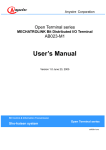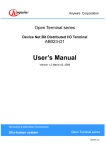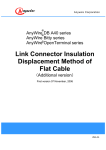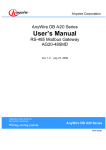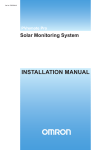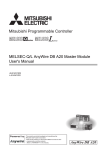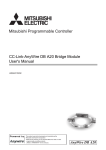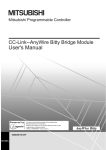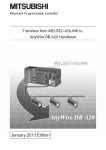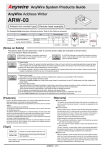Download User`s Manual
Transcript
Anywire Corporation R AnyWire DB A20 Series OMRON CJ1 PLC Interface AFCJ01-D2 User’s Manual Ver. 1.1 March 07, 2012 High speed transmission wiring saving system by full-duplex transmission method AnyWire DB A20 series PMA-08503A Cautionary Instructions Cautions about this manual 1. Please deliver this manual to end users. 2. Read this manual thoroughly to understand the contents before operating this product. 3. This manual explains the details of functions equipped with this product, and does not guarantee that the product will match a customer’s particular purpose. 4. Any reproduction or copying of this manual in whole or in part is expressly prohibited without permission. 5. Information in this manual may be subject to change without notice in the future. Warning displays A “WARNING” indicates a potentially hazardous situation which, if not ! WARNING ! CAUTION handled properly, could result in personal serious injury or death. A “CAUTION” indicates a potentially hazardous situation which, if not handled properly, could result in personal injury or property damage. Safety precautions ! WARNING The AnyWire system does not include any control functions to ensure safety. In any of the following cases, pay special attention to use with appropriate allowance for ratings and functions and implement safety measures such as a fail-safe design and consult us for: (1) Applications which require a high degree of safety ・Applications predicted to have a great impact on human life or property ・Medical equipment, safety equipment, etc. (2) When used in systems which require a higher degree of reliability ・Use in vehicle control, combustion control equipment, etc. Make sure to turn off the system power before installation or replacement work. Use the AnyWire system within the range of specifications and conditions defined in this manual. If current more than the rating or over-current by short-circuit continuously flows for a long time in this unit, smoke or ignition may result. Install a safety circuit such as a fuse externally. i ! CAUTION Do not turn on the 24V power before completing wiring and connection of the entire AnyWire system. Use a regulated, 24V DC power supply for AnyWire system equipment. Although the AnyWire system has high noise resistance, keep transmission cables and I/O cables away from high-voltage and power cables. Be careful to prevent any waste metal from entering inside of units or connector parts, especially during wiring. Miswiring may damage equipment. Pay attention to the cable length and layout in order to prevent connectors and cables from being removed. Do not solder a stranded wire to be connected to the terminal block; otherwise a contact failure may occur. If the wiring length of the power cable is long, voltage drops will occur and may cause shortages of the power voltage of remote slave units. In that case, connect local power supply units to ensure the specified voltage. Install the product by avoiding the following places: ・ Where exposed to direct sunlight or the ambient operating temperature exceeds the range of 0 C to 55 C ・ Where the operating relative humidity exceeds the range of 10% to 90% or condensation occurs due to rapid temperature changes ・ Where there is corrosive or inflammable gas ・ Where subjected to direct vibration or shock Tighten terminal screws securely to avoid malfunctions, etc. When storing the product, avoid high temperature and humidity. (Ambient storage temperature: -20 C to 75 C) Incorporate the emergency stop circuit or interlock circuit for safety in an external circuit other than the AnyWire system. ii CONTENTS 1 OVERVIEW.......................................................................................................................................................1-1 2 SPECIFICATIONS .........................................................................................................................................2-1 2.1. GENERAL SPECIFICATIONS ........................................................................................................................................ 2-1 2.2. PERFORMANCE SPECIFICATIONS ............................................................................................................................. 2-1 2.3. COMPATIBLE CPUS .................................................................................................................................................... 2-2 2.4. DIMENSIONAL OUTLINE DRAWING ............................................................................................................................ 2-3 2.5. NAME OF EACH PART .................................................................................................................................................. 2-3 2.6. UNIT ASSEMBLING ........................................................................................................................................................ 2-3 3 OPERATION MODE .....................................................................................................................................3-1 3.1. MACHINE NO. SETTING .............................................................................................................................................. 3-1 3.2. SPECIFICATION SELECTION (OPERATION MODE SETTING 2 SWITCH)........................................................... 3-1 3.3. INPUT AND OUTPUT POINT NUMBER SETTING (OPERATION MODE SETTING 1 SWITCH)............................ 3-2 4 MEMORY MAP................................................................................................................................................4-1 5 MONITORING FUNCTION .........................................................................................................................5-1 5.1. AUTOMATIC ADDRESS RECOGNITION ..................................................................................................................... 5-1 5.2. MONITORING OPERATION .......................................................................................................................................... 5-1 6 ERROR STATUS ...........................................................................................................................................6-1 6.1. ERROR FLAG ................................................................................................................................................................. 6-1 6.1.1. 6.2. How to reset error status.....................................................................................................................................................6-2 ERROR ADDRESS ......................................................................................................................................................... 6-2 7 LED DISPLAY .................................................................................................................................................7-1 8 CONNECTION.................................................................................................................................................8-1 8.1. 9 TERMINATOR ................................................................................................................................................................. 8-2 TRANSMISSION REQUIRED TIME .......................................................................................................9-1 9.1. IN THE CASE OF INPUT ................................................................................................................................................ 9-1 9.2. IN THE CASE OF OUTPUT ............................................................................................................................................ 9-1 10 TROUBLESHOOTING ....................................................................................................................... 10-1 11 HISTORY OF CHANGES .................................................................................................................. 11-1 iii Overview 1 Overview This unit is a master interface for the AnyWire DB A20 series that can be mounted on the OMRON CJ1 series PLC. The AnyWire system is a high speed, highly reliable wiring saving system by unique transmission method. Note) AnyWire is a registered trademark of Anywire Corporation. The AnyWire DB A20 series is a full-duplex transmission system which supports, in particular, high speed or long distance, and can input and output at a maximum 512 points respectively, and transmit by transmission distances of 50m, 200m, 1km and 3km. Disconnection can be detected even if branch wiring is carried out. SYSMAC CJ series PLC Input terminal Output terminal ・・ AnyWire system transmission line AFCJ01-D2 Input terminal ・・ Output terminal 1-1 Specifications 2 Specifications 2.1. General specifications Operating ambient temperature 0 ~ +55° C Operating ambient humidity 10 ~ 90% RH (No condensation) Storage ambient humidity Storage ambient temperature -20° C ~ +75° C Atmosphere No corrosive or inflammable gas Vibration proof JIS C 0040 compliant Noise proof 1200Vp-p (Pulse width 1μs) 2.2. Performance specifications Transmission clock Maximum transmission distance Transmission cable diameter Transmission method Connection mode Transmission protocol Error control Number of connecting IO points Number of connection nodes RAS functions 2kHz 7.8kHz 31.3kHz 125kHz 3km 1km 200m 50m 0.9 ~ 1.25 mm 2 0.75 ~ 1.25 mm Full-duplex cyclic method Bus type (Multi drop method, T-branch method, tree branch method) Dedicated protocol (AnyWireBus protocol) Double collation system Max. 1024 points (Input 512 points/Output 512 points) Max. 128 nodes (Fine =1) Transmission line disconnection position detecting function, transmission line short-circuit detecting function, transmission power drop detecting function Multi-purpose 2 line cable/4 line cable (VCTF 0.75 ~ 1.25mm Connection cable 2 2 rated temperature 60° C) 2 Dedicated flat cable (0.75mm rated temperature 70° C) 2 Multi-purpose electric wire (0.75~1.25mm rated temperature 60° C) 2 (If transmission distance exceeds 1 km, VCTF 1.25mm or more) Circuit: (Supply from CJ1 side) Voltage +5[V]±5% Current 0.4[A] Transmission line: Power supply Voltage 24V DC +15 ~ -10% (21.6~27.6V DC) ripple 0.5Vp-p or less Current 0.2[A] (Load current is not included when 128 terminal units are connected) 2-1 Specifications ■Maximum cycle time (Unit: ms) Operation mode setting 1 Transmission clock 1 0 512points (256 points×2) 1024 points (512 points×2) 2kHz 138.4 max. 265.4 max. 7.8kHz 35.8 max. 68.5 max. 31.3kHz 9.0 max. 17.2 max. 125kHz 2.3 max. 4.3 max. Caution: ① Transmission cycle time is a value between one cycle time and two cycle time. ② In order to ensure that input signal responds, issue input signal longer than two cycle time. 2.3. Compatible CPUs This machine corresponds to a high function IO unit. Installable CPUs are as follows. CJ1H-CPU6□H-R CJ1H-CPU6□H CJ1G-CPU4□H CJ1M-CPU1□ CJ1M-CPU1□-ETN CJ1M-CPU2□ CJ2M-CPU3□ CJ2M-CPU1□ CJ2H-CPU6□-EIP CJ2H-CPU6□ 2-2 Specifications 2.4. Dimensional outline drawing 2.5. Name of each part LED display LED表示部 号機№設定 Machine No. setting Operation mode setting 1 動作モード設定1 SETスイッチ SET switch Operation 動作モード設定2 mode setting 2 モニタ接続コネクタ Monitor connection connector Transmission line connection connector 伝送線接続コネクタ 2.6. Unit assembling After connecting the units, slide the upper and lower sliders until a clicking sound is heard to securely lock. Note that the functions may not be fulfilled unless locked. Make sure to install the end cover attached to the CPU unit onto the rightmost unit. Unless the end cover is installed, the CJ series will not operate properly. 2-3 Operation Mode 3 Operation Mode 3.1. Machine No. setting Set the machine No. by the two rotary dip switches on this machine. Since this machine occupies 4 machines by one unit, set the number within the range from “0” to “92.” For example, “04” to “07” are occupied when “04” is set. Do not set this number for other unit(s) within this range. 3.2. Specification selection (Operation Mode setting 2 switch) Select transmission distance etc., with the operation mode setting 2 switch (quad dip switch). SW-1, 2 SW-3 Sets transmission distance by combination of ON/OFF with 1 and 2. Setting switch for Bit mode operation. Use this in OFF. SW-4 System reserve (Use this in OFF.) ON on right side *All the default switch positions are at “OFF.” Operation mode 2 switch Specification 1 2 2kHz 3km OFF OFF 7.8kHz 1km OFF ON 31.3kHz 200m ON OFF 125kHz 50m ON ON Operation mode 2 switch 3 Operation Specification mode Carry out double collation for data every bit (1 OFF Bit mode point). Use Bit type for slave. Turn OFF when using. 3-1 Operation Mode 3.3. Input and output point number setting (Operation mode setting 1 switch) Select input and output point number with the operation mode setting 1 switch (rotary DIP switch). Operation mode Operation mode 1 switch Input Output 512 points 512 points 0 256 points 256 points 1 512 points 512 points 2~F ! CAUTION Make sure to turn off the power to set the DIP switch. Make sure to set the DIP switch according to the transmission specification to be used. Unless the DIP switch meets the transmission specification of the slave unit connected to this machine, transmission cannot be properly made, or a malfunction may result. 3-2 Memory Map 4 Memory Map Offset address Description 0 ~ 31 Output 32 ~ 63 System reserve 64 (32ch) (32ch should not be used) Error reset output 65 ~ 67 System reserve (1 word) (3ch should not be used ) 200 ~ 231 Input (32ch) 232 ~ 263 System reserve 264 Error flag input 265 Address response error slave unit number input 266 ~ 281 Error address 282 ~ 283 System reserve (32ch should not be used ) (1ch) (1ch) (16ch) (2ch should not be used) (System reserve area should not be used.) Data is mapped to the area after channel DM2000 is determined by the machine No. The start channel No. is obtained by: Start channel No.= 20000 + Offset address + Machine No. × 100 <Example> When the machine No. is “4”: The start channel No. for output is from DM20400, by: 20000 + 0 + 4 The start channel No. for input is from DM20600, by: 20000 + 200 + 4 100. 100. Correspondence between word address No. and data memory on AnyWireBus is as follows. Offset address ch No. Output Input Bit No. ① 15 14 13 12 11 10 9 8 7 6 5 4 3 2 1 0 0 DM20400 15 14 13 12 11 10 9 8 7 6 5 4 3 2 1 0 1 DM20401 31 30 29 28 27 26 25 24 23 22 21 20 19 18 17 16 ¦ ¦ ¦ 31 DM20431 511 510 509 508 507 506 505 504 503 502 501 500 499 498 497 496 200 DM20600 15 14 13 12 11 10 9 201 DM20601 31 30 29 28 27 26 25 24 23 22 21 20 19 18 17 16 8 7 6 5 4 3 2 1 0 ¦ ¦ ¦ 231 DM20631 511 510 509 508 507 506 505 504 503 502 501 500 499 498 497 496 <Note> The ① column in the table shows an example when the machine No. is set to “4.” Numbers from 1 to 511 in the table represent the address No. on the AnyWireBus. 4-1 Memory Map Because the DM area cannot be handled by bit, it can be handled by relocating it to internal auxiliary relay. Use block transmission instruction XFER for relocation. Reference program for relocating input data P_On Always ON XFER &32 Transmission CH number D20600 Transmission source lower CH No. 1200 Transmission destination lower CH No. Reference program for relocating output data P_On Always ON XFER &32 Transmission CH number 1300 Transmission source lower CH No. D20400 Transmission destination lower CH No. No. of the internal auxiliary relay used here is a reference example. Specify appropriate No. which is not used in other areas of the program. In this example, input is mapped to 1200.00 through 1231.15, and output is mapped to 1300.00 through 1331.15. Note Other than the above, this machine occupies an area of 40 channels after channel 2000 is determined by the machine No. Do not use this area. The start channel No. is obtained by: Start channel No. = 2000 + Offset address + Machine No. 10 <Example> When the machine No. is “4”: The start channel No. is from 2040, by: 2000 + 0 + 4 10. Channel 2040 through 2079 are occupied by this machine. 4-2 Monitoring Function 5 Monitoring function Overview The slave units of the AnyWire system have their own addresses, and a slave unit which has an address which was sent from this machine returns responses to the address, then detects for disconnection and checks for existence of a slave unit. This machine stores an address of the slave unit which is connected at that time by the automatic address recognition operation (described later) into EEPROM. This information is stored even if the power is turned off. Then registered addresses are sequentially sent out, and if there is no response to them, disconnection is displayed by the “ALM” LED, and an error flag is returned. In addition, addresses of the slave units having errors can be known, 5.1. Automatic address recognition Storing addresses of the connected slave units into EEPROM of this machine is called “Automatic address recognition.” 〔Procedure〕 1 Check that all of the slave units operate normally. 2 Press the “SET” switch until the “SET” LED (Green) lights up. 3 If the “SET” LED lights up for a while and then turns off, storage of an address has been completed. 〔Timing of automatic address recognition operation〕 ・When all terminals are connected to the master and operation is started ・When some terminals are added ・When some terminals are removed ・When the address of a terminal is changed ! Automatic address recognition operation cannot be made at the CAUTION time of an error in an AnyWire transmission line such as a shortcircuit, after the power is turned on, or for approximately 5 seconds after resetting. If any disconnection error occurs during operation, do not perform the automatic address recognition operation. Disconnection information will be lost. 5.2. Monitoring operation Addresses registered in this machine are sequentially sent out, and if there is no response to them, disconnection is displayed by the “ALM” LED. Bit 3 of the error flag is set to “1”. This error information is retained until the power is turned off or the error is reset. (Refer to the item of error status.) 5-1 Error Status 6 Error status The status of a transmission line can be known by the error status of this machine. The error status consists of a number of addresses from which an error flag and disconnection are detected and the 16 error addresses. If any error by disconnection occurs, the applicable slave unit can be known from the information of the number of addresses and information on an error address. If there are 16 or more error addresses, 16 addresses are displayed sequentially in the order of the most recent number. Correspondence between error information and data memory is as follows. Offset address ② ch No. Description 264 DM20664 Error flag 265 DM20665 Number of error address 266 DM20666 Error address 1 267 DM20667 Error address 2 268 DM20668 Error address 3 ¦ ¦ ¦ 280 DM20680 Error address 15 281 DM20681 Error address 16 <Note> The ② column in the table shows an example when the machine No. is set to “4.” 6.1. Error flag An error flag can be read by setting the offset address to 264. The number of error addresses can be read by setting the offset address to 265. This status can also be displayed by the “ALM” LED. The associated bit becomes “1” if any error occurs. Bit 3 is retained until the power is turned off, or an error is reset (described later). Bit 0, 1 and 2 become “0” when an error status is cancelled. They are not retained. Bit 0 Short-circuit between D and G Bit 1 Short-circuit between D and P Bit 2 24V is not supplied, or voltage is low. Bit 3 Disconnected. Or slave unit failed, or power is not supplied. Bit 4~15 6-1 Reserved Error Status 6.1.1. How to reset error status Write “1” into the data memory area of the offset address 64. If an error such as disconnection is eliminated, the disconnection flag is reset to “0” and the number of error addresses is also reset to “0.” Unless an error condition is eliminated, the number of error flags and error address are set, and the error address is set again. An error is also cleared by turning on power again. Offset address ② Ch No. Description 64 DM20464 Error reset output <Note> The ② column in the table shows an example when the machine No. is set to “4.” 6.2. Error address When disconnection or any error in the slave unit occurs, up to 16 error addresses are written into the offset addresses 266 to 281. (See 4 Memory map.) Values written are classified according to the following table. Hexadecimal display address Description 000~1FF Address of output slave 200~3FF Address of input slave The lower 2 digits represent the address set for the slave unit. The uppermost digit represents the type of slave unit. This value is retained until the error is reset or the power is turned OFF. 6-2 LED Display 7 LED Display LED indicating the status of this unit LED Name Color RUN Operating Green ERC Unit error Red ERH CPU unit error Red Indication Lit Unlit Lit Unlit Lit Unlit This unit is operating. This unit is in a stopped state. This unit has an error. This unit is normal. There is an error caused by the CPU unit. The CPU unit is normal. Main causes of ERC LED and ERH LED lighting Causes of ERC LED This unit is not recognized as a high-performance I/O unit. lighting Hardware check error The machine No. is not set within the range of 00 to 92. Double setting of a machine No. Causes of ERH LED No units registered in the I/O table. lighting I/O bus error CPU watchdog timer error LED indicating AnyWireBus status LED LINK Name Transmission display Color Green address recognition Flashing This unit is operating. Unlit This unit has an error. Lit Display on SET Indication Green operation In Unlit display Flashing Writing in EEPROM Disconnection of AnyWireBus D, G. Slow flashing Red Short-circuit between D and G, or short-circuit between D and 24V. *2 Quick flashing Unlit 24V is not supplied, or voltage is low. On normal transmission. *1 : “Slow flashing” is flashing of approximately 1 second period. *2 : “Quick flashing” is flashing of approximately 0.2 seconds period. In profile rewrite mode, ERC and ERH are displayed as follows: 7-1 LED Name Color ERC Unit error Red ERH CPU unit error Red recognition In normal transmission. *1 ALM address operation. Lit Alarm automatic Indication Lit Flashing Lit Normal termination Abnormal termination Profile rewrite mode display Connection 8 Connection Use 2-wire or 4-wire VCTF, VCT (rated temperature 60° C) cable or dedicated flat cable (FK4075-100:rated temperature 70° C). See page 2-1 for wire diameter. For the power line, make connection using a wire diameter in consideration of voltage drop. AnyWireBus connecting terminal of this machine is provided with quick detachable connector terminals. Model : MC1.5/5-STF-3.81 (manufactured by PHOENIX CONTACT) Connectable cable : 0.14 ~ 1.5mm (AWG28 ~ 16) Tightening torque : 0.22 ~ 0.25N・m 2 D Transmission cable G Transmission cable 24V 0V Connect a regulated 24V DC power supply. Power supply with capacity of current necessary for load and slave unit and +0.2A or more Connected to neutral point of noise filter. Ground when there is a malfunction due to 24V based power LG noise. In this case, ground to the function grounding terminal of PLC at one point. Connect D and G with D and G of the slave unit respectively. (Refer to the instruction manual of each unit.) ! MONITOR connector CAUTION Connector for connecting maintenance monitor. Connect nothing. 8-1 Connection 8.1. Terminator In order to ensure more stable transmission quality, connect a terminator (AT2) to the transmission line end. This terminator is a module to stabilize wave form, and has polarity. Connect properly. ■Connection of terminator Basic Nece Connect one AT2 to the foremost end for one master. Transmission distance 50m (Total extension) 200m ( 〃 ) 1km ( 〃 ) 3km ( 〃 ) Common to the respective transmission speed. ■Branch of transmission line (Transmission distance 1km specification) ■Total extension [Example of connection] Basic Fixed one piece Branch 200m A Main line 500m B Branch 300m Req. Connect one AT2 to the terminal end for locations of a branch length 200m or longer. If there are three or more locations of a branch length 200m or longer, contact us. ! “Total extension” of transmission distance referred to in the AnyWire DB A20 series means A+B. When branching, make sure not to exceed the maximum transmission distance (total extension) set by the system. CAUTION Do not send some transmission lines (D, G) in a multicore cable all together. If sent all together, the equipment will malfunction due to crosstalk. D G D D G D G G 2 The transmission cable shall be 0.75 to 1.25mm in wire diameter. The lower limit of the power voltage is down to 21.6V, however, the voltage shall not be below 24V in the master. Watch out for voltage drop by cable. Voltage drop will cause the equipment to malfunction. If the voltage drops significantly, supply power on the terminal side. (local power supply) Do not solder wires connected to the connector terminal. The wire may loosen, resulting in a contact failure. 8-2 Transmission Required Time 9 Transmission Required Time 9.1. In the case of input Because the master side does not update data (double collation) unless the same data consecutively continues two times, the transmission cycle time requires transmission time of a minimum one cycle time and maximum two cycle time. Signals of two cycle times or less may not be captured depending on the timing. Therefore, in order to ensure a response, provide an input signal of two cycle times or longer. Minimum transmission cycle time Case of minimum transmission cycle 1 cycle time Input data update Change in input data Maximum transmission cycle time 2 cycle times Case of maximum transmission cycle Change in input data Input data update 9.2. In the case of output Because the slave unit side performs double collation, it requires transmission time of a minimum one cycle time and maximum two cycle times similar to the case of input. Terminology Transmission cycle time: Repeated transmission time of actual data transmitted Maximum transmission delay time: Processing time on master side+Transmission cycle time+Signal delay time on slave side Response delay time is as shown in the following diagram. Input and output equipment Input Output ①Input equipment response time AnyWire system ⑨Output equipment response time ⑧Slave side signal delay time ②Slave side signal delay time ③Transmission cycle time ⑦Transmission cycle time ④Master side processing time ⑥Master side processing time Maximum transmission delay time Maximum transmission delay time PLC ⑤PLC processing time 9-1 Troubleshooting 10 Troubleshooting Check the following at the start. (1) The “RDY” lamps for all units of the equipment shall light up. (2) The “LINK” lamps for all units of the equipment shall flash. (3) The power voltages for all units of the equipment shall be in a range from 21.6 to 27.6V. (4) Wiring and connection shall be secured. (5) Address setting shall be correct, and not be duplicated. Checklist by symptom Symptom Check Item AFCJ01-D2 side MODE switch is correctly set. I/O configuration set with the MODE switch is consistent with I/O No. specified by the software. Data cannot be input and output Slave unit side Power is supplied to the slave unit. Address of the slave unit is correctly set. Slave unit of the same specification as that of AFCJ01-D2 (such as transmission clock and number of input and output) is used. D, G lines are not disconnected. ALM LED (Red) lights up Address automatic recognition operation is correctly performed. Screws on the terminal blocks are not loosened. ALM LED (Red) slowly D, G lines are not short-circuited. flashes D does not contact 24V ALM LED (Red) quickly flashes ERC LED lights up Voltage of 24V DC power supplied to AFCJ01-D2 is normal. Securely connected to the adjacent unit. Setting of machine No. is in a range from 0 to 92. ERH LED lights up Machine No. the same as that of the other unit is not set. I/O table is set. 10-1 ERR/ALM LED of CPU The end cover attached to the CPU is installed to the rightmost lights up unit. History of Change 11 History of Changes Version Date 1.0 January 6, 2005 1.1 March 7, 2012 Change Description Formal version released Cable rate temperature additionally described, contact information changed 11-1 Anywire Corporation URL: http://www.anywire.jp ■ Headquarters / West Japan Office 8-1, Shimoinden, Inouchi, Nagaokakyo-shi, Kyoto 617-0813 JAPAN TEL: (+81) 75-956-1611 FAX: (+81) 75-956-1613 ■ East Japan Office Shin-Koei Bldg. 6F, 47, Kandakonya-cho, Chiyoda-ku, Tokyo 101-0035 JAPAN TEL: (+81) 3-5209-5711 FAX: (+81) 3-5209-5713 ■ Chubu Office 5-1-14 Yadaminami, Higashi-ku, Nagoya-shi, Aichi 453-0014 JAPAN TEL: (+81) 52-452-8711 FAX: (+81) 52-452-8713 ■ Kyushu Office No. 6 Myojyo Bldg. 7F, 1-15-2 Tenjin, Chuo-ku, Fukuoka-shi, Fukuoka 830-0059 JAPAN TEL: (+81) 942-46-9811 FAX: (+81) 942-46-9813 ■ Kyoto Factory 19-2, Umatate, Kamiueno-cho, Muko-shi, Kyoto 617-0006 JAPAN TEL: (+81) 75-922-1911 FAX: (+81) 75-922-1913
























